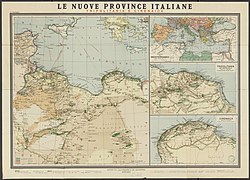Libyan resistance movement
This article has multiple issues. Please help improve it or discuss these issues on the talk page. (Learn how and when to remove these messages)
|
| Libyan resistance movement (1923-1943) | |||||||
|---|---|---|---|---|---|---|---|
| |||||||
| Belligerents | |||||||
|
| |||||||
| Commanders and leaders | |||||||
|
|
| ||||||
| Strength | |||||||
| ~856,000 soldiers | Thousands | ||||||
| Casualties and losses | |||||||
| unknown |
40,000[1]-70,000 dead[2] (battles, deportation, starvation etc.). | ||||||
| History of Libya | ||||||||||||||||||||||||||||||||||||||
|---|---|---|---|---|---|---|---|---|---|---|---|---|---|---|---|---|---|---|---|---|---|---|---|---|---|---|---|---|---|---|---|---|---|---|---|---|---|---|
 | ||||||||||||||||||||||||||||||||||||||
|
||||||||||||||||||||||||||||||||||||||
|
| ||||||||||||||||||||||||||||||||||||||
The Libyan resistance movement was the resistance movement against the Italian colonization of Libya.
History
Second Italo-Senussi War (1923-1932)
The Libyan resistance was initially led by Omar Mukhtar (Arabic عمر المختار ‘Umar Al-Mukhtār) (1862 - 16 September 1931), who was from the tribe of Mnifa, born in a small village called Janzour located in the eastern part of Barqa. He was the leader for almost ten years starting in 1923.
Later King Idris and his Senussi tribe in the provinces of Cyrenaica and Tripolitania started to become opposed to the Italian colonization after 1929, when Italy changed its political promises of moderate "protectorate" to the Senussi (done in 1911) and - because of Benito Mussolini - started to take complete colonial control of Libya.
Resistance was totally crushed by General Rodolfo Graziani in the 1930s and the country was fully controlled by the Italians with the help of Arab fascists, to the point that many Libyan colonial troops fought on the side of Italy between 1940 and 1943: two divisions of Libyan colonial troops were created in the late 1930s and 30,000 native Libyans fought for Italy during World War II.
World War II (1940-1943)

In 1940 the Libyans in the coastal areas were granted Italian citizenship as part of the fascist efforts to create the Imperial Italy in Tripolitania and Cyrenaica. This reduced the appeal of the Libyan resistance movement to a few Arab/Berbers populations of the Fezzan area only, but this was practically non-existent until the arrival of French troops in the area in 1942. The Fezzan was occupied by the Free French in 1943. At the close of World War II the British and French collaborated with the small new resistance. France and the United Kingdom decided to make King Idris the Emir of an independent Libya in 1951.
See also
- Gasr Bu Hadi
- Resistance during World War II
- Italy's 'Fourth Shore'
- World War II
- Libya
- The concept of Italia irredenta
- The Italian Mare Nostrum
References
External links
- http://countrystudies.us/libya/20.htm
- http://www.workmall.com/wfb2001/libya/libya_history_world_war_ii_and_independence.html
- https://archive.org/search.php?query=collection%3A%22opensource_movies%22%20AND%20(subject%3A%22%20World%20War%20II%22)
- http://countrystudies.us/libya/23.htm
- http://countrystudies.us/libya/20.htm
- http://www.workmall.com/wfb2001/libya/libya_history_world_war_ii_and_independence.html
- http://www.archive.org/search.php?query=collection%3A%22opensource_movies%22%20AND%20(subject%3A%22%20World%20War%20II%22)
- http://countrystudies.us/libya/23.htm
- http://smallwarsjournal.com/jrnl/art/arab-thoughts-on-the-italian-colonial-wars-in-libya
- http://quod.lib.umich.edu/cgi/t/text/text-idx?c=acls;cc=acls;view=toc;idno=heb00880.0001.001
- http://histclo.com/country/arab/lib/hist/lh-ita.html
- http://www.globalsecurity.org/military/world/libya/senussi.htm
- http://countrystudies.us/libya/20.htm
- https://www.onwar.com/aced/chrono/index2010.htm

